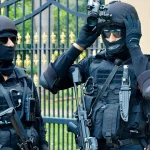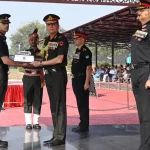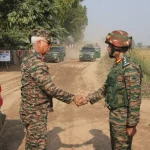The Rashtriya Rifles (RR) stands as a formidable pillar of India’s internal security apparatus. Established in 1990, this specialized force was conceptualized to confront the dual challenges of insurgency and terrorism, particularly in the sensitive region of Jammu and Kashmir (J&K). As a counter-insurgency unit of the Indian Army, the Rashtriya Rifles operates under the Ministry of Defence, embodying a commitment to peace, stability, and internal security in conflict-affected areas. The evolution of the RR reflects not only India’s proactive measures towards safeguarding its territorial integrity but also highlights the ongoing complexities surrounding internal strife and its intricate socio-political dynamics.
Historical Context
The late 20th century marked a significant turning point in India’s security landscape, primarily due to the rise of insurgency in the northern regions, especially in Jammu and Kashmir. The formation of the Rashtriya Rifles cannot be viewed in isolation; it emerged in response to escalating violence and unrest sparked by various groups challenging the state’s authority.
The Rashtriya Rifles was formally raised on 1 October 1990, under the leadership of then Chief of Army Staff, General S. F. Rodrigues, with Lieutenant General P. C. Mankotia acting as the first Director General. This development represented a strategic shift, as the Indian Army recognized the need for a specialized force distinctly trained for counter-insurgency operations.
Initially formed from an amalgamation of resources from two Indian Army corps, the RR began with approximately 75,000 troops, all drawn from the regular Army on deputation. The early deployment strategy focused on placing six battalions—three in Punjab and three in Jammu and Kashmir—geographically aligned to counter the immediate threats. By 1994, the RR had evolved into a dedicated force with 36 battalions exclusively operating in Jammu and Kashmir, underscoring its role as a crucial player in the service of national security.
Structure and Organization
Today, the Rashtriya Rifles has expanded to 65 battalions, organized into five Counter Insurgency Forces (CIFs). Each of these forces is led by a Major General and assigned to specific operational sectors primarily covering the Kashmir Valley and Jammu division.
The major CIFs include:
- Victor Force
- Kilo Force (under XV Corps)
- Delta Force
- Romeo Force (under XVI Corps)
- Uniform Force (a later creation)
Each RR battalion aims to maintain full authorized manpower strength and undergoes an extensive and rigorous training regimen, which includes an 8-week counter-insurgency school focused on specialized tactics essential for effective missions in hostile environments. This structural organization not only enhances operational effectiveness but also fosters inter-unit cohesion and camaraderie among soldiers drawn from various infantry regiments.
Roles and Powers
The primary function of the Rashtriya Rifles is to conduct counter-insurgency operations that neutralize militant threats while restoring law and order in conflict zones. They operate under the Armed Forces (Jammu and Kashmir) Special Powers Act, 1990 (AFSPA), giving them the legal authority to engage in military actions that civilians could not undertake.
In their day-to-day functions, the RR embraces a multifaceted approach:
- Military Operations: Direct combat with insurgents and militants, leading raids, and executing targeted operations based on intelligence.
- Coordination with Local Forces: Working closely with local police and intelligence agencies to stabilize conflict zones, support civil administration, and foster regional security.
- Civic Assistance Programs: Engaging with local communities to address grievances and develop relations that enhance communal harmony and cooperation.
In recent years, the need for the RR’s deployment has been recognized beyond Jammu and Kashmir. There are discussions about assigning RR battalions to other insurgency-affected states like Chhattisgarh, Jharkhand, Maharashtra, and addressing security concerns in the sensitive areas bordering China in the northeastern regions.
Equipment and Capabilities
The operational effectiveness of the Rashtriya Rifles is complemented by advanced equipment and training. Units are equipped with:
- Modern small arms and ammunitions tailored to the demands of counter-insurgency operations.
- Bullet-proof jackets and protective gear enhancing soldier survival rates during missions.
- Specialized communication equipment ensuring real-time coordination and intelligence sharing among units.
The uniqueness of the RR also lies in its personnel. Soldiers hail from diverse regimental backgrounds, each contributing individual skills and experience to the collective capacity of the force. Their training not only sharpens their tactical acumen but also instills a shared understanding of the complex challenges presented in environments marked by insurgency and unrest.
Motto and Ethos
The motto of the Rashtriya Rifles—“Dridhta Aur Veerta”, meaning *Determination and Valour*—perfectly encapsulates the spirit of this elite formation. The soldiers are volunteers from various Indian Army units, meticulously selected based on their capability and motivation to undertake the arduous tasks associated with counter-insurgency operations. This ethos underscores the strength of commitment, discipline, and ethical conduct in the challenging missions they undertake.
Statistical Data and Research Insights
The impact of the Rashtriya Rifles in conflict management and counter-terrorism has been significant. Between its inception in 1990 and recent years, the RR has:
- Engaged in thousands of operations in Jammu and Kashmir, leading to the apprehension or neutralization of numerous insurgents.
- Facilitated peacebuilding initiatives resulting in enhanced regional stability, as demonstrated by reduced incidents of violence in areas where RR units are deployed.
According to reports, the deployment of RR forces has directly correlated with a decline in militant activities in specific districts, showcasing their effectiveness in restoring order. For example, in the past decade, areas under Kilo Force reported over 30% reduction in incidents of violence due to systematic operations led by the RR.
Challenges and Solutions
While the Rashtriya Rifles has made significant strides in combating insurgency, it faces numerous challenges:
- Human Rights Issues: Under AFSPA, RR’s operations are sometimes met with allegations of human rights violations. This has led to calls for accountability and oversight to ensure compliance with international norms.
- Local Perception: The presence of military forces in civilian spaces can foster resentment among local populations, complicating counter-insurgency efforts.
To address these challenges, potential solutions could include:
- Engaging with local communities to build trust and understanding.
- Implementing robust human rights training for RR personnel to mitigate violations and emphasize lawful engagement in operations.
- Strengthening collaboration with civil administrators and local authorities to promote collaborative security and socio-developmental programs aimed at achieving lasting peace.
Future Trends and Predictions
Looking ahead, the role and strategy of the Rashtriya Rifles may witness transformative changes in response to the evolving security landscape of India. Factors influencing these changes could include:
- Technological Advancements: Increased use of surveillance drones, intelligence-gathering technology, and warfare strategies could redefine how RR conducts operations.
- Operational Scope: Given the growing threats of terrorism and insurgency in regions beyond Kashmir, the RR’s expansions into other conflict-prone areas suggest a broader operational capability that may be needed to adapt to a changing landscape.
- Increased Inter-agency Coordination: As the nature of conflict becomes more complex, the necessity for enhanced cooperation between the army, local police, and intelligence agencies will likely become paramount.
Conclusion
The Rashtriya Rifles has established itself as a crucial player in India’s internal security, particularly in addressing the persistent challenges posed by insurgency and terrorism in Jammu and Kashmir. Its formation marks a critical chapter in India’s strategic response towards maintaining peace and stability in volatile regions.
As it continues to develop and adapt to an ever-evolving security environment, the RR’s future will undoubtedly shape not only the security framework of J&K but might also play an influential role in India’s broader internal security strategy. For those seeking a deeper understanding of military strategy and operations, including the RR’s intricacies, platforms like SSBCrack and SSBCrackExams offer invaluable resources for aspirants keen on joining the ranks of India’s armed forces. As we reflect on the RR’s contributions, it is imperative to acknowledge the balancing act between operational effectiveness and the moral obligations intrinsically tied to such powerful roles in the security landscape.













